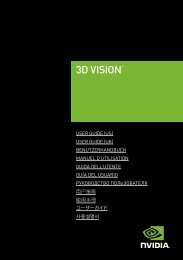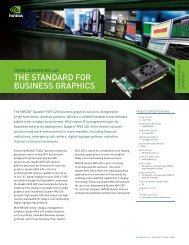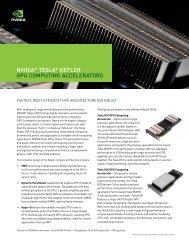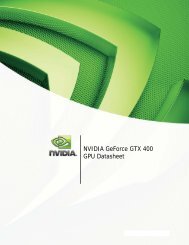Tegra 4 Whitepaper - Nvidia
Tegra 4 Whitepaper - Nvidia
Tegra 4 Whitepaper - Nvidia
- No tags were found...
You also want an ePaper? Increase the reach of your titles
YUMPU automatically turns print PDFs into web optimized ePapers that Google loves.
P a g e | 17rendering, the memory controller can opportunistically put system memory into lowpower state.Display Request Grouping: The GPU groups multiple display requests, and issuesthese requests in bursts to system memory. Then the GPU informs the memorycontroller (via timers) about the timing of the next request burst. In the idle periodbetween GPU display request bursts, the memory controller looks for opportunities toaggressively and dynamically put system memory in low power states.Dynamic Voltage and Frequency Scaling (DVFS): During period of low GPUutilization, GPU clocks and voltage can be dropped to lower levels to greatly reduce idlepower consumption. When an incoming task is detected, the frequency and voltagelevels are immediately increased to the appropriate operating values to ensure higherperformance. The DVFS software intelligently raises the voltage and frequency only upto a level that is required to deliver the performance demanded by the application. TheDVFS algorithm has very fine control over the frequency levels, and can increase ordecrease frequency in steps as small as 1 MHz.<strong>Tegra</strong> GPU / Memory Controller InterfaceBeing built on a 28nm manufacturing process, the NVIDIA ® <strong>Tegra</strong> ® 4 SoC now includes a dualchannel(2 x 32-bit) memory subsystem for increased performance. The memory subsystem isshared by various SoC processing cores including CPU, GPU, Video and Audio. Up to 4GB ofphysical memory can be addressed. Supported memory types for both <strong>Tegra</strong> 4 and 4iprocessors include DDR3L-1866 and LPDDR3-1866, and the <strong>Tegra</strong> 4i processor also supportsLPDDR3-2133.The <strong>Tegra</strong> Memory Controller (MC) maximizes memory utilization while providing minimumlatency access for critical CPU and GPU requests. An arbiter is used to prioritize requests,optimizing memory access efficiency and utilization, and minimizing system power consumption.The MC provides access to main memory for all internal devices. It optimizes access to sharedmemory resources, balancing latency and efficiency to provide the best system performancebased on programmable parameters.The MC is built by NVIDIA and is highly tuned to the specific requirements of the <strong>Tegra</strong>processor’s GPU, and includes several optimizations that enhance GPU performance andreduce power consumption including:Dynamic Clock Speed Control (DCSC): DCSC enables the memory controller toquickly ramp up operating frequency in response to advanced indicators from the GPUcore for system memory accesses, and quickly ramp down operating frequency to apower saving levels when the GPU has completed its memory accesses.GPU centric Memory Arbitration: The MC implements advanced arbitration schemesto efficiently grant multiple clients access to system memory. The MC core has advancedknowledge of the type and urgency of memory access requests coming in from a GPUNVIDIA <strong>Tegra</strong> 4 GPU Architecture February 2013
















